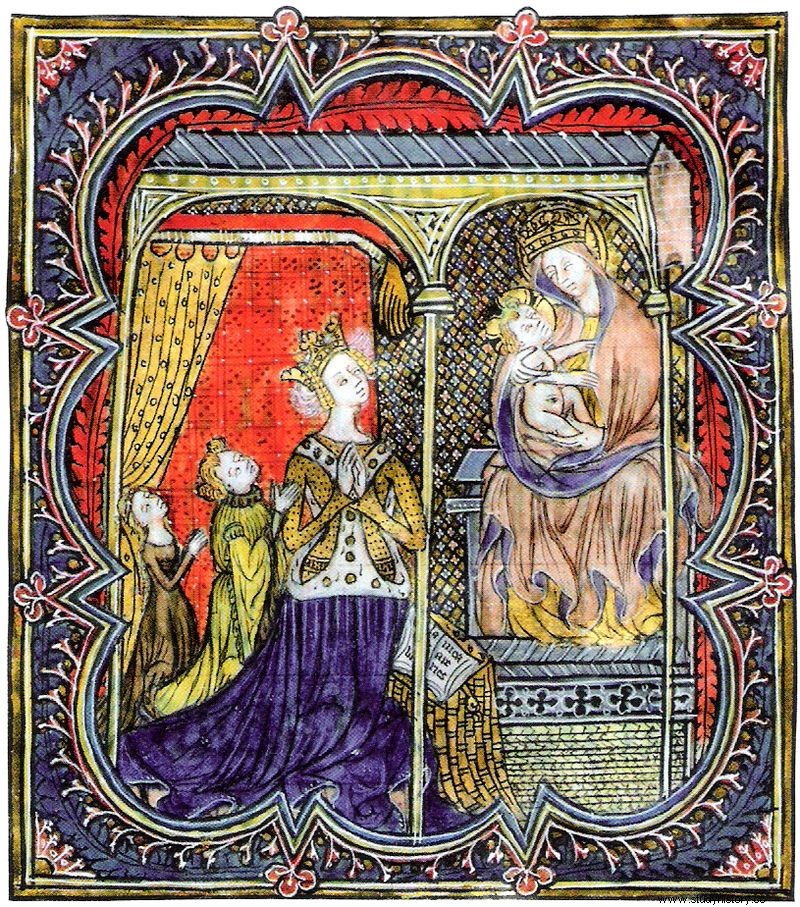Yolande of Aragon, also known as Jolantha de Aragon (circa 1382 – 1442), Duchess of Anjou, Countess of Maine and Provence, Queen of Naples and Jerusalem, played an important political role in the West in the 15th century.
Queen consort of Naples
 Daughter of Yolande de Bar, herself granddaughter of King Jean II le Bon of France, and of King Jean Iᵉʳ of Aragon, Yolande d'Aragon was born between 1381 and 1384 in Saragossa, Aragon. She is the second of seven siblings, but will be the only one to survive childhood. Her father also had five children from a first marriage, of whom only Joan of Aragon reached adulthood.
Daughter of Yolande de Bar, herself granddaughter of King Jean II le Bon of France, and of King Jean Iᵉʳ of Aragon, Yolande d'Aragon was born between 1381 and 1384 in Saragossa, Aragon. She is the second of seven siblings, but will be the only one to survive childhood. Her father also had five children from a first marriage, of whom only Joan of Aragon reached adulthood.
In 1389, while Yolande was still a little girl, marriage negotiations began on the initiative of Marie de Blois, mother of Louis II who had just been crowned King of Naples. At first, the proposal of Marie de Blois is rejected
A few years later, the King of England Richard II seeks in turn to obtain the hand of Yolande, but the King of France Charles VI prevents the union by marrying his own daughter Isabelle of France to Richard II. In 1396, Jean Iᵉʳ of Aragon died and Marie de Blois finally managed to convince Yolande's family to give her in marriage to Louis II. The marriage took place in Arles in December 1400; Yolande, aged about 17, becomes queen consort of Naples. The couple will have six children, five of whom reach adulthood.
The Throne of Aragon
Jean Iᵉʳ died without surviving male heirs. His daughter Joan of Aragon and her husband claim the throne, but the laws of succession of Aragon, unclear on the subject, are interpreted in favor of the closest male relative; it is the brother of John Iᵉʳ, Martin Iᵉʳ of Aragon, who inherits the throne. On the death of Jeanne d'Aragon, in 1407, Yolande was the only surviving child of Jean Iᵉʳ and, as such, claimed the throne, as she would do again on the death of Martin Iᵉʳ, who died without an heir in 1410 After two years of conflict, the States of Aragon elect Ferdinand of Antequera King of Aragon. Yolande and her sons will continue to see themselves as the legitimate heirs to the throne and to use the title of Kings of Aragon.
The Hundred Years War
In the Hundred Years War, Yolande of Aragon sided with France against England and her allies. With the queen of France Isabeau of Bavaria, she arranged a marriage between her daughter Marie d'Anjou and the third surviving son of the kings of France, Charles, who would become Charles VII. The death of his older brothers made Charles the Dauphin of France, but in 1420 the Treaty of Troyes, marking a defeat for France, deprived him of the throne in favor of the King of England. Isabella of Bavaria ratifies her son's deposition and opposes his claims to the crown. Yolande, recently widowed, shelters Charles in her castles in the Loire Valley and protects him from plots and machinations, refusing to send him back to the court of his parents. “We did not nurture and cherish this one for you to cause him to die like his brothers or go mad like his father, or become English like you. I keep it for myself. Come get it, if you dare. » she would have replied to the Queen of France.
The marriage of Charles and Marie d'Anjou took place in 1422, and Yolande became the mother-in-law of the man who proclaimed himself king of France, despite the Treaty of Troyes. In this pivotal period of the Hundred Years War, Yolande played a crucial role as adviser to Charles VII. She chooses her relatives, advisers and servants, and ousts some of them. She has networks of influencers in the main courts of France, and does not hesitate to recruit beautiful young women to make them the mistresses of important men, including her son-in-law. Among Joan of Arc's early supporters, Yolande likely played a role in her arrival at court; thereafter, it will finance its army, this army which will take again Orleans. Intelligent and daring, Yolande acts in the shadows to defend, as a priority, the interests of the house of Anjou.
"A man's heart in a woman's body"
Yolande d'Aragon retired to Angers then to Saumur, from where she continued to pull the strings. She died at the Château de Tuce-de-Saumur on December 14, 1443. The chronicle Charles de Bourdigné, said of her that she was considered "as the wisest and most beautiful princess of Christianity" . For her grandson Louis XI, she had "a man's heart in a woman's body .
